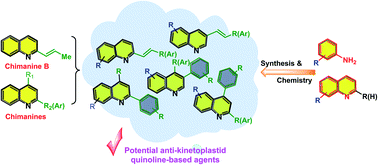Recent synthetic efforts in the preparation of 2-(3,4)-alkenyl (aryl) quinoline molecules towards anti-kinetoplastid agents
Abstract
Leishmaniasis, Chagas disease and African sleeping sickness have been considered some of the most important tropical protozoan afflictions. As the number of drugs currently available to treat these human illnesses is severely limited and the majority has poor safety profiles and complicated administration schedules, actually there is an urgent need to develop new effective, safe and cost-effective drugs. Because quinoline alkaloids with antiprotozoal activity (quinine, chimanine, cryptolepine or huperzine groups) were historically and are still essential models for drug research to combat these parasitic infections, synthetic or semi-synthetic quinoline-based molecules are important for anti-kinetoplastid drug design approaches and synthetic methods of their preparation become a key task that is the central subject of this review. Its goal is to highlight the advances in the conventional and current syntheses of new 2-(3,4)-alkenyl (aryl) quinoline derivatives, which kill the most important kinetoplastid protozoa, – Leishmania and Trypanosoma and could be useful models for antileishmanial and antitrypanosomal research. An attempt has been made to present and discuss the more recent contributions in this field over the period 2015–2019, paying special attention to molecular design, synthetic efforts to new green reaction conditions for classical methods such as Skraup synthesis, Friedländer synthesis, Conrad–Limpach, Doebner–Miller, as well as contemporary methods like Gould–Jacobs, Meth–Cohn and Povarov reactions. This review includes brief general information on these neglected tropical diseases, their current chemotherapies, and primary natural models (quinoline alkaloids), suitable for development of anti-kinetoplastid quinoline-based agents. The main part of the review comprises critical discussion on the synthesis and chemistry of new quinolines diversely substituted by alkyl (alkenyl, aryl) fragments on the pyridine part of the quinoline skeleton, which could be considered interesting analogues of chimanine alkaloids. The methods described in this review were developed with the aim of overcoming the drawbacks of the traditional protocols using revolutionary precursors and strategies.

- This article is part of the themed collection: 2020 Reviews in RSC Advances


 Please wait while we load your content...
Please wait while we load your content...